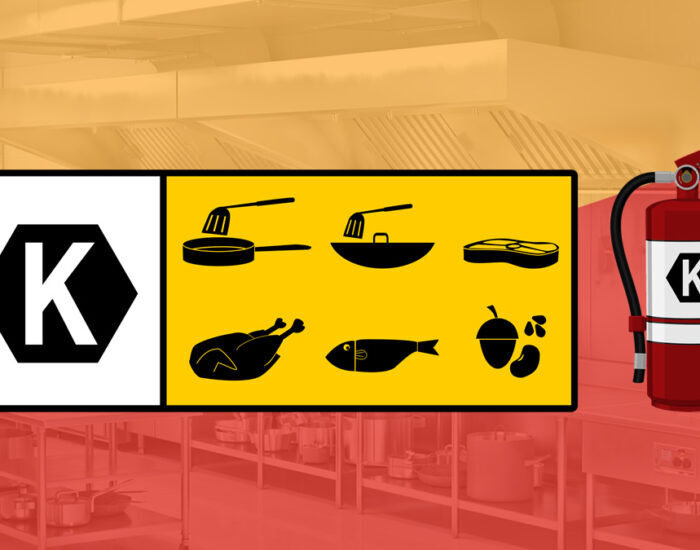When deciding which type of fire extinguisher is the best for your needs, it’s important to know about all of the different types and their intended purposes. The most common fire extinguisher we think of is the smaller red canister, known as an ABC extinguisher, that most people may have in their homes. These are usually dry chemical or foam fire extinguishers and are good at putting out a number of different types of burning materials.
The “A” classification is suitable for common solid combustibles like wood, paper, or cloth. A “B” classification means that the extinguisher is capable of putting out some flammable liquids like gas or oil. And lastly, the “C” classification means that it should be capable of putting out fires within energized electrical equipment such as a breaker box.
It’s important to note that red fire extinguishers have been a prominent color choice in both the US and the UK. This is simply to better determine a fire extinguisher’s location in the event of a blackout or low-light situation where visibility could affect locating an extinguisher in a fire emergency.
Class D extinguishers are usually yellow, Class K extinguishers are usually silver or chrome, and water mist extinguishers are most often white.
Due to the lack of regulated color standardization, it’s important to ensure you have the proper signage detailing what the fire extinguisher is used for posted. In a commercial kitchen, a wet chemical fire extinguisher should always be present.
There are many different types of fire extinguishers available, each with its own unique performance strengths. It’s important to know that also fire extinguishers are not suitable for all fires. The ABC extinguisher is popular due to its versatility. However, some environments require specialty fire extinguishers, particularly in restaurants and commercial kitchens. These are called wet chemical fire extinguishers and are the most specific type of fire extinguisher with an extremely specific purpose.
What Is a Wet Chemical Fire Extinguisher?
 A wet chemical fire extinguisher is a fire extinguisher that’s specifically designed to put out oil fires in a commercial kitchen setting. These fire extinguishers carry an extinguisher classification of K. The “K” classification means that these extinguishers are suitable for commercial cooking oil appliances such as a deep fryer. And unlike most other fire extinguishers, K-class extinguishers may require special training since the materials inside are electrically conductive.
A wet chemical fire extinguisher is a fire extinguisher that’s specifically designed to put out oil fires in a commercial kitchen setting. These fire extinguishers carry an extinguisher classification of K. The “K” classification means that these extinguishers are suitable for commercial cooking oil appliances such as a deep fryer. And unlike most other fire extinguishers, K-class extinguishers may require special training since the materials inside are electrically conductive.
Wet chemical fire extinguishers should only be used on a cooking oil appliance once the electrical power has been turned off. This is a common feature of most commercial kitchen hood fire suppression systems.
What Ingredients Are In a Wet Chemical Extinguisher?
The ingredients of a web chemical fire extinguisher can consist of a few different chemical combinations: water and potassium acetate, potassium carbonate, and potassium citrate.
These ingredients help to combat the high temperatures of cooking oils by quickly reducing heat and sealing the oil within the soapy solution to prevent the oil or grease from reigniting.
When Should You Use a Wet Chemical Fire Extinguisher?
Wet chemical fire extinguishers are used to put out a fire from vegetable and animal-based fats. Since these oils are highly flammable, the mixture of the oil plus extremely high heat can ignite quickly.
A wet chemical fire extinguisher contains ingredients that create a soapy substance when combined with cooking oils that extinguish the flame, cool on contact, and seal the oil to prevent reignition.
Remember, you should NEVER use water on a grease or oil fire. Since water isn’t absorbed by oil but rather acts as a transport mechanism, this usually results in increased fire spread.
How Does a Wet Chemical Fire Extinguisher Differ From Other Extinguishers?
The biggest difference is their intent — wet chemical fire extinguishers are specifically designed to put out oil and grease fires in kitchens. Another big difference is that these extinguishers usually have a long hose to allow the user to stand back at a safe distance from the fire. Most fire extinguishers don’t have a hose, or if they do, they’re usually shorter.
It’s important to remember that wet chemical fire extinguishers contain electrical conductive ingredients and should not be used on kitchen appliances with an active electrical current. Doing so could result in serious injury or death.
We Can Help Keep Your Kitchen Safe
Having the right fire extinguisher can mean the difference between life and death. The safety precautions that you take today can help prevent a catastrophe tomorrow. Your business depends on it!
Our experts have over 40 years of fire safety expertise — contact us today for a hassle-free fire safety evaluation!





